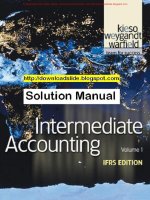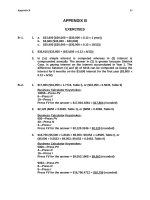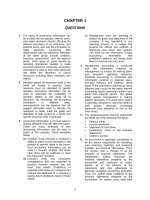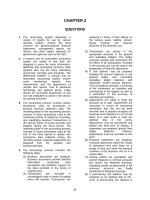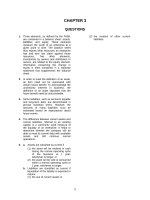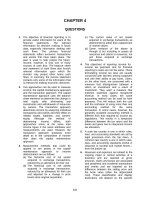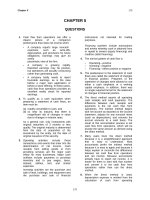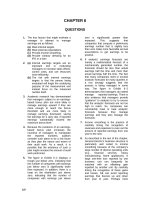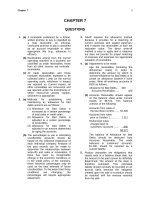Solution manual intermediate accounting 7th by nelson spiceland ch09
Bạn đang xem bản rút gọn của tài liệu. Xem và tải ngay bản đầy đủ của tài liệu tại đây (684.17 KB, 72 trang )
Find more slides, ebooks, solution manual and testbank on www.downloadslide.com
Chapter 9
Inventories: Additional Issues
QUESTIONS FOR REVIEW OF KEY TOPICS
Question 9-1
GAAP generally require the use of historical cost to value assets, but a departure from cost is
necessary when the utility of an asset is no longer as great as its cost. The utility or benefits from
inventory result from the ultimate sale of the goods. This utility could be reduced below cost due to
deterioration, obsolescence, or changes in price levels. To avoid reporting inventory at an amount
greater than the benefits it can provide, the lower-of-cost-or-market approach to valuing inventory
was developed. This approach results in the recognition of losses when the value of inventory
declines below its cost, rather than in the period in which the goods are ultimately sold.
Question 9-2
The designated market value in the LCM rule is the middle number of replacement cost (RC),
net realizable value (NRV) and net realizable value less a normal profit margin (NRV-NP). This is
the amount compared with cost to determine LCM.
Question 9-3
The LCM determination can be made based on individual inventory items, on logical
categories of inventory, or on the entire inventory.
Question 9-4
The preferred method is to record the loss from the write-down of inventory as a separate item
in the income statement rather than including the write-down in cost of goods sold. A less desirable
alternative is to include the loss in cost of goods sold.
Question 9-5
The gross profit method estimates cost of goods sold, which is then subtracted from cost of
goods available for sale to obtain an estimate of ending inventory. The estimate of cost of goods
sold is found by multiplying sales by the historical ratio of cost to selling prices. The cost
percentage is the reciprocal of the gross profit ratio.
Question 9-6
The key to obtaining accurate estimates when using the gross profit method is the reliability of
the cost percentage. If the cost percentage is too low, cost of goods sold will be understated and
ending inventory overstated. Cost percentages usually are based on relationships of past years,
which aren’t necessarily representative of the current relationship. Failure to consider theft or
spoilage also could cause an overstatement of ending inventory.
Solutions Manual, Vol.1, Chapter 9
© The McGraw-Hill Companies, Inc., 2007
9-1
Find more slides, ebooks, solution manual and testbank on www.downloadslide.com
Answers to Questions (continued)
Question 9-7
The retail inventory method first determines the amount of ending inventory at retail by
subtracting sales for the period from goods available for sale at retail. Ending inventory at retail is
then converted to cost by multiplying it by the cost-to-retail percentage.
Question 9-8
The main difference between the gross profit method and the retail inventory method is in the
determination of the cost percentage used to convert sales at selling prices to sales at cost. The retail
inventory method uses a cost percentage, called the cost-to-retail percentage, which is based on a
current relationship between cost and selling price. The gross profit method relies on past data to
reflect the current cost percentage.
Question 9-9
Initial markup — Original amount of markup from cost to selling price.
Additional markup — Increase in selling price subsequent to initial markup.
Markup cancellation — Elimination of an additional markup.
Markdown — Reduction in selling price below the original selling price.
Markdown cancellation — Elimination of a markdown.
Question 9-10
When using the retail method to estimate average cost, the cost-to-retail percentage is
determined by dividing total cost of goods available for sale by total goods available for sale at
retail. By including beginning inventory in the calculation of the cost-to-retail percentage, the
percentage reflects the average cost/retail relationship for all inventory, not just the portion acquired
in the current period.
Question 9-11
The lower-of-cost-or-market (LCM) retail variation combined with the average cost method is
called the conventional retail method. The LCM rule is incorporated into the retail inventory
estimation procedure by excluding markdowns from the calculation of the cost-to-retail percentage.
Question 9-12
When applying LIFO, if inventory increases during the year, none of the beginning inventory
is assumed sold. Ending inventory includes the beginning inventory plus the current year’s layer.
To determine layers, we compare ending inventory at retail to beginning inventory at retail and
assume that no more than one inventory layer is added if inventory increases. Each layer carries its
own cost-to-retail percentage that is used to convert each layer from retail to cost.
Question 9-13
Freight-in is added to purchases in the cost column. Net markups are added in the retail
column before the calculation of the cost-to-retail percentage. Normal spoilage is deducted in the
retail column after the calculation of the cost-to-retail percentage. If sales are recorded net of
employee discounts, the discounts are added to net sales before sales are deducted in the retail
column.
© The McGraw-Hill Companies, Inc., 2007
9-2
Intermediate Accounting,4/e
Find more slides, ebooks, solution manual and testbank on www.downloadslide.com
Answers to Questions (continued)
Question 9-14
The dollar-value LIFO retail method eliminates the stable price assumption of regular retail
LIFO. In effect, it combines dollar-value LIFO (Chapter 8) with LIFO retail. Before comparing
beginning and ending inventory at retail prices, ending inventory is deflated to base year retail using
the current year’s retail price index. After identifying the layers in ending inventory with the years
they were created, in addition to converting retail prices to cost using the cost-to-retail percentage,
the dollar-value LIFO method requires that each layer first be converted from base year retail to
layer year retail using the year’s retail price index.
Question 9-15
Changes in inventory methods, other a change to the LIFO method, are reported
retrospectively. This means reporting all previous periods’ financial statements as if the new
inventory method had been used in all prior periods.
Question 9-16
When a company changes to the LIFO inventory method from any other method, it usually is
impossible to calculate the income effect on prior years. To do so would require assumptions as to
when specific LIFO inventory layers were created in years prior to the change. As a result, a
company changing to LIFO usually does not report the change retrospectively. Instead, the LIFO
method simply is used from that point on. The base year inventory for all future LIFO
determinations is the beginning inventory in the year the LIFO method is adopted.
Question 9-17
If a material inventory error is discovered in an accounting period subsequent to the period in
which the error is made, any previous years’ financial statements that were incorrect as a result of
the error are retrospectively restated to reflect the correction. And, of course, any account balances
that are incorrect as a result of the error are corrected by journal entry. If retained earnings is one of
the incorrect accounts, the correction is reported as a prior period adjustment to the beginning
balance in the statement of shareholders’ equity. In addition, a disclosure note is needed to describe
the nature of the error and the impact of its correction on net income, income before extraordinary
item, and earnings per share.
Solutions Manual, Vol.1, Chapter 9
© The McGraw-Hill Companies, Inc., 2007
9-3
Find more slides, ebooks, solution manual and testbank on www.downloadslide.com
Answers to Questions (concluded)
Question 9-18
2004:
2005:
Cost of goods sold
Net income
Ending retained earnings
Net purchases
Cost of goods sold
Net income
Ending retained earnings
overstated
understated
understated
no effect
understated
overstated
correct
Question 9-19
Purchase commitments are contracts that obligate the company to purchase a specified amount
of merchandise or raw materials at specified prices on or before specified dates. These agreements
are entered into primarily to secure the acquisition of needed inventory and to protect against
increases in purchase price.
Question 9-20
Purchases made pursuant to a purchase commitment are recorded at the lower of contract price
or market price on the date the contract is executed. A loss is recognized if the market price is less
than the contract price. For purchase commitments outstanding at year-end, a loss is recognized if
the market price at year-end is less than the contract price.
© The McGraw-Hill Companies, Inc., 2007
9-4
Intermediate Accounting,4/e
Find more slides, ebooks, solution manual and testbank on www.downloadslide.com
BRIEF EXERCISES
Brief Exercise 9-1
NRV = $30 - 4 = $26
NRV – NP = $26 – (30% x $30) = $17
RC = $18
The designated market is the middle value of NRV, NRV-NP, and RC, which is
$18. Since this is lower than the cost of $20, the unit value is $18.
Brief Exercise 9-2
(1)
(2)
Ceiling
NRV (*)
(3)
Floor
NRV-NP
(**)
Product
RC
1
$48
$64
$54
2
26
32
24
(4)
(5)
Cost
Per Unit
Inventory
Value
[Lower of (4)
and (5)]
$54
$50
$50
26
30
26
Designated
Market Value
[Middle value
of (1), (2) & (3)]
* Selling price less disposal costs.
** NRV less normal profit margin
Product 1 (1,000 units)
Product 2 (1,000 units)
Cost
LCM value
Cost
$50,000
30,000
$80,000
LCM
$50,000
26,000
$76,000
Before-tax income will be lower by $4,000, the amount of the required inventory
write-down.
Solutions Manual, Vol.1, Chapter 9
© The McGraw-Hill Companies, Inc., 2007
9-5
Find more slides, ebooks, solution manual and testbank on www.downloadslide.com
Brief Exercise 9-3
Beginning inventory (from records)
Plus: Net purchases (from records)
Cost of goods available for sale
Less: Cost of goods sold:
Net sales
Less: Estimated gross profit of 30%
Estimated cost of goods sold
Estimated cost of inventory destroyed
$220,000
400,000
620,000
$600,000
(180,000)
(420,000)
$200,000
Brief Exercise 9-4
Beginning inventory (from records)
Plus: Net purchases (from records)
Cost of goods available for sale
Less: Cost of goods sold:
Net sales
Less: Estimated gross profit
Estimated cost of goods sold
Estimated cost of inventory lost
$150,000
450,000
600,000
$700,000
( ? )
( ? )
$ 75,000
Estimated cost of goods sold = $600,000 – 75,000 = $525,000*
Estimated gross profit = $700,000 – 525,000* = $175,000
$175,000 ÷ $700,000 = 25% gross profit ratio
© The McGraw-Hill Companies, Inc., 2007
9-6
Intermediate Accounting,4/e
Find more slides, ebooks, solution manual and testbank on www.downloadslide.com
Brief Exercise 9-5
Cost
$300,000
861,000
22,000
Beginning inventory
Plus: Net purchases
Freight-in
Net markups
Less: Net markdowns
Goods available for sale
______
1,183,000
Retail
$ 450,000
1,210,000
48,000
(18,000)
1,690,000
$1,183,000
Cost-to-retail percentage:
= 70%
$1,690,000
Less: Net sales
Estimated ending inventory at retail
Estimated ending inventory at cost (70% x $490,000)
Estimated cost of goods sold
Solutions Manual, Vol.1, Chapter 9
(1,200,000)
$ 490,000
(343,000)
$ 840,000
© The McGraw-Hill Companies, Inc., 2007
9-7
Find more slides, ebooks, solution manual and testbank on www.downloadslide.com
Brief Exercise 9-6
Beginning inventory
Plus: Net purchases
Freight-in
Net markups
Less: Net markdowns
Goods available for sale (excluding beg. Inventory)
Goods available for sale (including beg. Inventory)
Cost
$300,000
861,000
22,000
_______
883,000
1,183,000
Retail
$450,000
1,210,000
48,000
(18,000)
1,240,000
1,690,000
$883,000
Cost-to-retail percentage:
= 71.21%
$1,240,000
Less: Net sales
Estimated ending inventory at retail
Estimated ending inventory at cost:
Retail
Cost
Beginning inventory $ 450,000
$ 300,000
Current period’s layer
40,000 x 71.21 % = 28,484
Total
$ 490,000
$328,484 (328,484)
Estimated cost of goods sold
$854,516
© The McGraw-Hill Companies, Inc., 2007
9-8
(1,200,000)
$ 490,000
Intermediate Accounting,4/e
Find more slides, ebooks, solution manual and testbank on www.downloadslide.com
Brief Exercise 9-7
Cost
$300,000
861,000
22,000
Beginning inventory
Plus: Net purchases
Freight-in
Net markups
Goods available for sale
Retail
$ 450,000
1,210,000
48,000
1,708,000
$1,183,000
Cost-to-retail percentage:
= 69.26%
$1,708,000
Less: Net markdowns
______
Goods available for sale
1,183,000
Less: Net sales
Estimated ending inventory at retail
Estimated ending inventory at cost (69.26% x $490,000) (339,374)
Estimated cost of goods sold
$ 843,626
Solutions Manual, Vol.1, Chapter 9
(18,000)
1,690,000
(1,200,000)
$ 490,000
© The McGraw-Hill Companies, Inc., 2007
9-9
Find more slides, ebooks, solution manual and testbank on www.downloadslide.com
Brief Exercise 9-8
Cost
$220,000
640,000
17,800
Beginning inventory
Plus: Purchases
Freight-in
Plus: Net markups
Retail
$ 400,000
1,180,000
16,000
1,596,000
$877,800
Cost-to-retail percentage:
= 55%
$1,596,000
Less: Net markdowns
Goods available for sale
Less:
Normal spoilage
Net sales*
_______
877,800
Estimated ending inventory at retail
Estimated ending inventory at cost (55% x $272,000) (149,600)
Estimated cost of goods sold
$728,200
(6,000)
1,590,000
(3,000)
(1,315,000)
$272,000
*$1,300,000 + 15,000 (employee discounts) = $1,315,000
© The McGraw-Hill Companies, Inc., 2007
9-10
Intermediate Accounting,4/e
Find more slides, ebooks, solution manual and testbank on www.downloadslide.com
Brief Exercise 9-9
Cost
$ 40,800
155,440
Beginning inventory
Plus: Net purchases
Net markups
Less: Net markdowns
Goods available for sale (excluding beginning inventory)
Goods available for sale (including beginning inventory)
_______
155,440
196,240
Retail
$ 68,000
270,000
6,000
(8,000)
268,000
336,000
$40,800
Base layer cost-to-retail percentage:
= 60%
$68,000
$155,440
2006 layer cost-to-retail percentage:
= 58%
$268,000
Less: Net sales
Estimated ending inventory at current year retail prices
Estimated ending inventory at cost (calculated below)
Estimated cost of goods sold
(250,000)
$ 86,000
(50,451)
$145,789
___________________________________________________________________________
Ending
Inventory
at Year-end
Retail Prices
Step 1
Ending
Inventory
at Base Year
Retail Prices
Step 2
Inventory
Layers
at Base Year
Retail Prices
Step 3
Inventory
Layers
Converted to
Cost
$86,000
$86,000
(above)
= $84,314
1.02
$68,000 (base)
16,314 (2006)
x 1.00 x 60% =
x 1.02 x 58% =
Total ending inventory at dollar-value LIFO retail cost ......................
Solutions Manual, Vol.1, Chapter 9
$40,800
9,651
$50,451
© The McGraw-Hill Companies, Inc., 2007
9-11
Find more slides, ebooks, solution manual and testbank on www.downloadslide.com
Brief Exercise 9-10
Cost
$ 50,451
168,000
Beginning inventory
Plus: Net purchases
Net markups
Less: Net markdowns
Goods available for sale (excluding beginning inventory)
Goods available for sale (including beginning inventory)
_______
168,000
218,451
Retail
$ 86,000
301,000
3,000
(4,000)
300,000
386,000
$155,440
2006 layer cost-to-retail percentage:
= 58%
$268,000
$168,000
2007 layer cost-to-retail percentage:
= 56%
$300,000
Less: Net sales
Estimated ending inventory at current year retail prices
Estimated ending inventory at cost (calculated below)
Estimated cost of goods sold
(280,000)
$106,000
(59,762)
$158,689
___________________________________________________________________________
Ending
Inventory
at Year-end
Retail Prices
Step 1
Ending
Inventory
at Base Year
Retail Prices
Step 2
Inventory
Layers
at Base Year
Retail Prices
Step 3
Inventory
Layers
Converted to
Cost
$106,000
$106,000
(above)
= $100,000
1.06
$68,000 (base)
16,314 (2006)
15,686 (2007)
x 1.00 x 60%* =
x 1.02 x 58% =
x 1.06 x 56% =
Total ending inventory at dollar-value LIFO retail cost ......................
© The McGraw-Hill Companies, Inc., 2007
9-12
$40,800
9,651
9,311
$59,762
Intermediate Accounting,4/e
Find more slides, ebooks, solution manual and testbank on www.downloadslide.com
*$40,800 ÷ $68,000 = 60%
Brief Exercise 9-11
Hopyard applies the FIFO cost method retrospectively; that is, to all prior periods
as if it always had used that method. In other words, all financial statement amounts
for individual periods that are included for comparison with the current financial
statements are revised for period-specific effects of the change.
Then, the cumulative effects of the new method on periods prior to those
presented are reflected in the reported balances of the assets and liabilities affected as
of the beginning of the first period reported and a corresponding adjustment is made
to the opening balance of retained earnings for that period.
The effect of the change on each line item affected should be disclosed for each
period reported as well as any adjustment for periods prior to those reported. Also, the
nature of and justification for the change should be described in the disclosure notes.
2006 cost of goods sold is $7,000 higher than it would have been if Hopyard had
not switched to FIFO. This is because beginning inventory is $18,000 higher
($145,000 – 127,000) and ending inventory is $11,000 higher ($162,000 – 151,000).
An increase in beginning inventory causes an increase in cost of goods sold, but an
increase in ending inventory causes a decrease in cost of goods sold. Purchases for
2006 are the same regardless of the inventory valuation method used.
Brief Exercise 9-12
When a company changes to the LIFO inventory method from any other method,
it usually is impossible to calculate the income effect on prior years. To do so would
require assumptions as to when specific LIFO inventory layers were created in years
prior to the change. As a result, a company changing to LIFO usually does not report
the change retrospectively. Instead, the LIFO method simply is used from that point
on. The base year inventory for all future LIFO determinations is the beginning
inventory in the year the LIFO method is adopted, $150,000 in this case.
A disclosure note is needed to explain (a) the nature of and justification for the
change, (b) the effect of the change on current year's income and earnings per share,
and (c) why retrospective application was impracticable.
Solutions Manual, Vol.1, Chapter 9
© The McGraw-Hill Companies, Inc., 2007
9-13
Find more slides, ebooks, solution manual and testbank on www.downloadslide.com
Brief Exercise 9-13
The 2004 error caused 2004 net income to be overstated, but since 2004 ending
inventory is 2005 beginning inventory, 2005 net income was understated the same
amount. So, the income statement was misstated for 2004 and 2005, but the balance
sheet (retained earnings) was incorrect only for 2004. After that, no account balances
are incorrect due to the 2004 error.
Analysis:
2004
Beginning inventory
Plus: net purchases
Less: ending inventory
Cost of goods sold
Revenues
Less: cost of goods sold
Less: other expenses
Net income
Retained earnings
© The McGraw-Hill Companies, Inc., 2007
9-14
U = Understated
O = Overstated
→
↑
O →
U
U
O
O
2005
Beginning inventory
Plus: net purchases
Less: ending inventory
Cost of goods sold
O
O
Revenues
Less: cost of goods sold
Less: other expenses
Net income
Retained earnings
O
U
corrected
Intermediate Accounting,4/e
Find more slides, ebooks, solution manual and testbank on www.downloadslide.com
Brief Exercise 9-13 (concluded)
However, the 2005 error has not yet self-corrected. Both retained earnings and
inventory still are overstated as a result of the second error.
Analysis:
2005
Beginning inventory
Plus: net purchases
Less: ending inventory
Cost of goods sold
Revenues
Less: cost of goods sold
Less: other expenses
Net income
Retained earnings
U = Understated
O = Overstated
O
U
U
O
O
Retained earnings on January 1, 2006, in this case, would be overstated by
$500,000 (ignoring income taxes).
Brief Exercise 9-14
The financial statements that were incorrect as a result of both errors (effect of
one error in 2004 and effect of two errors in 2005) would be retrospectively restated
to report the correct inventory amounts, cost of goods sold, income, and retained
earnings when those statements are reported again for comparative purposes in the
current annual report. A “prior period adjustment” to retained earnings would be
reported, and a disclosure note should describe the nature of the error and the impact
of its correction on each year’s net income, income before extraordinary items, and
earnings per share.
Solutions Manual, Vol.1, Chapter 9
© The McGraw-Hill Companies, Inc., 2007
9-15
Find more slides, ebooks, solution manual and testbank on www.downloadslide.com
EXERCISES
Exercise 9-1
(1)
(2)
Ceiling
(3)
Floor
(4)
(5)
Cost
Per Unit
Inventory
Value
[Lower of (4)
and (5)]
$29
$20
$20
50
80
90
80
48
48
50
48
NRV-NP
(**)
Product
RC
NRV (*)
1
$18
$ 34
$29
2
85
80
3
40
60
Designated
Market Value
[Middle value
of (1), (2) & (3)]
* Selling price less disposal costs.
** NRV less normal profit margin
© The McGraw-Hill Companies, Inc., 2007
9-16
Intermediate Accounting,4/e
Find more slides, ebooks, solution manual and testbank on www.downloadslide.com
Exercise 9-2
Requirement 1
(1)
(2)
Ceiling
(3)
Floor
(4)
(5)
NRV-NP
Designated
(NP=
Market Value
25%
[Middle value
of cost) of (1), (2) & (3)]
Cost
Inventory
Value
[Lower of
(4) and (5)]
$100,000
$120,000
$100,000
87,500
87,500
90,000
87,500
50,000
35,000
40,000
60,000
40,000
50,000
42,500
42,500
Totals
30,000
$300,000
30,000
$257,500
Product
RC
NRV
101
$110,000
$100,000
$70,000
102
85,000
110,000
103
40,000
104
28,000
The inventory value is $257,500.
Requirement 2
Loss from write-down of inventory: $300,000 - 257,500 = $42,500
Exercise 9-3
Beginning inventory (from records)
Plus: Net purchases (from records)
Cost of goods available for sale
Less: Cost of goods sold:
Net sales
Less: Estimated gross profit of 25%
Estimated cost of goods sold
Estimated cost of inventory destroyed
Solutions Manual, Vol.1, Chapter 9
$140,000
370,000
510,000
$550,000
(137,500)
(412,500)
$ 97,500
© The McGraw-Hill Companies, Inc., 2007
9-17
Find more slides, ebooks, solution manual and testbank on www.downloadslide.com
Exercise 9-4
Beginning inventory (from records)
Plus: Net purchases (from records)
Cost of goods available for sale
Less: Cost of goods sold:
Net sales
Less: Estimated gross profit of 35%
Estimated cost of goods sold
Estimated ending inventory
Less: Value of usable damaged goods
Estimated loss from fire
$100,000
140,000
240,000
$220,000
(77,000)
(143,000)
97,000
(12,000)
$ 85,000
Exercise 9-5
Merchandise inventory, January 1, 2006
Purchases
Freight-in
Cost of goods available for sale
Less: Cost of goods sold:
Sales
Less: Estimated gross profit of 20%
Estimated loss from fire
© The McGraw-Hill Companies, Inc., 2007
9-18
$1,900,000
5,800,000
400,000
8,100,000
$8,200,000
(1,640,000)
(6,560,000)
$1,540,000
Intermediate Accounting,4/e
Find more slides, ebooks, solution manual and testbank on www.downloadslide.com
Exercise 9-6
Beginning inventory + Net purchases - Ending inventory = Cost of goods sold
$27,000 + 31,000 - 28,000 = $30,000 = Cost of goods sold
Cost of goods sold
Cost percentage =
Net sales
$30,000
Cost percentage =
= 60%
$50,000
Exercise 9-7
Cost
$35,000
19,120
Beginning inventory
Plus: Net purchases
Net markups
Less: Net markdowns
Goods available for sale
______
54,120
Retail
$50,000
31,600
1,200
(800)
82,000
$54,120
Cost-to-retail percentage:
= 66%
$82,000
Less: Net sales
Estimated ending inventory at retail
Estimated ending inventory at cost (66% x $50,000)
Estimated cost of goods sold
Solutions Manual, Vol.1, Chapter 9
(32,000)
$50,000
(33,000)
$21,120
© The McGraw-Hill Companies, Inc., 2007
9-19
Find more slides, ebooks, solution manual and testbank on www.downloadslide.com
Exercise 9-8
Cost
$190,000
600,000
8,000
Beginning inventory
Plus: Purchases
Freight-in
Net markups
Retail
$ 280,000
840,000
20,000
1,140,000
$798,000
Cost-to-retail percentage:
= 70%
$1,140,000
Less: Net markdowns
Goods available for sale
Less: Net sales
Estimated ending inventory at retail
Estimated ending inventory at cost (70% x $336,000)
© The McGraw-Hill Companies, Inc., 2007
9-20
_______
798,000
(4,000)
1,136,000
(800,000)
$ 336,000
$235,200
Intermediate Accounting,4/e
Find more slides, ebooks, solution manual and testbank on www.downloadslide.com
Exercise 9-9
Beginning inventory
Plus: Net purchases
Net markups
Less: Net markdowns
Goods available for sale (excluding beg. Inventory)
Goods available for sale (including beg. Inventory)
Cost
$160,000
607,760
_______
607,760
767,760
Retail
$ 280,000
840,000
20,000
(4,000)
856,000
1,136,000
$607,760
Cost-to-retail percentage:
= 71%
$856,000
Less: Net sales
Estimated ending inventory at retail
Estimated ending inventory at cost:
Retail
Cost
Beginning inventory
$280,000
$160,000
Current period’s layer
56,000 x 71% = 39,760
Total
$336,000
$199,760
Estimated cost of goods sold
Solutions Manual, Vol.1, Chapter 9
(800,000)
$ 336,000
(199,760)
$568,000
© The McGraw-Hill Companies, Inc., 2007
9-21
Find more slides, ebooks, solution manual and testbank on www.downloadslide.com
Exercise 9-10
Cost
$ 12,000
102,600
3,480
(4,000)
Beginning inventory
Plus: Purchases
Freight-in
Less: Purchase returns
Plus: Net markups
Retail
$ 20,000
165,000
(7,000)
6,000
184,000
$114,080
Cost-to-retail percentage:
= 62%
$184,000
Less: Net markdowns
Goods available for sale
Less:
Normal spoilage
Net sales
Estimated ending inventory at retail
Estimated ending inventory at cost (62% x $24,800)
Estimated cost of goods sold
© The McGraw-Hill Companies, Inc., 2007
9-22
_______
114,080
(3,000)
181,000
(4,200)
(152,000)
$ 24,800
(15,376)
$ 98,704
Intermediate Accounting,4/e
Find more slides, ebooks, solution manual and testbank on www.downloadslide.com
Exercise 9-11
Requirement 1
Cost
$ 40,000
207,000
14,488
(4,000)
Beginning inventory
Plus: Purchases
Freight-in
Less: Purchase returns
Plus: Net markups
Retail
$ 60,000
400,000
(6,000)
5,800
459,800
$257,488
Cost-to-retail percentage:
= 56%
$459,800
Less: Net markdowns
_______
Goods available for sale
257,488
Less:
Normal breakage
Sales:
Net sales
$280,000
Add back employee discounts
1,800
Estimated ending inventory at retail
Estimated ending inventory at cost (56% x $168,500)
(94,360)
Estimated cost of goods sold
$163,128
(3,500)
456,300
(6,000)
(281,800)
$168,500
Requirement 2
Net markdowns are included in the cost-to-retail percentage:
$257,488
Cost-to-retail percentage:
= 56.43%
$456,300
Solutions Manual, Vol.1, Chapter 9
© The McGraw-Hill Companies, Inc., 2007
9-23
Find more slides, ebooks, solution manual and testbank on www.downloadslide.com
Exercise 9-12
Net purchases:
Using LIFO, the beginning inventory is excluded from the calculation of the cost-toretail percentage:
Cost of goods available (excluding beg. inventory)
Cost-to-retail percentage =
Goods available at retail (excluding beg. inventory)
$10,500
50% =
, and x = $21,000.
x
Net purchases at retail equals $21,000 less markups plus markdowns.
Net purchases = $21,000 - 4,000 + 1,000 = $18,000
Net sales:
The cost-to-retail percentage can be calculated as follows:
Cost
Retail
$21,000.00 $ 35,000
10,500.00 18,000
4,000
_________
(1,000)
31,500.00 56,000
Beginning inventory
Plus: Net purchases
Net markups
Less: Net markdowns
Goods available for sale
$31,500
Cost-to-retail percentage:
= 56.25%
$56,000
Less: Net sales
Estimated ending inventory at retail
Estimated ending inventory at cost (56.25% x ?) =
(
?
?
)
$17,437.50
Estimated ending inventory at retail is:
$17,437.50
= $31,000
.5625
© The McGraw-Hill Companies, Inc., 2007
9-24
Intermediate Accounting,4/e
Find more slides, ebooks, solution manual and testbank on www.downloadslide.com
Net sales = $56,000 - 31,000 = $25,000
Exercise 9-13
1.
2.
3.
4.
b
c
d
c
Exercise 9-14
Cost
$ 71,280
112,500
Beginning inventory
Plus: Net purchases
Net markups
Less: Net markdowns
Goods available for sale (excluding beginning inventory)
Goods available for sale (including beginning inventory)
_______
112,500
183,780
Retail
$132,000
255,000
6,000
(11,000)
250,000
382,000
$71,280
Base year cost-to-retail percentage:
= 54%
$132,000
$112,500
2006 cost-to-retail percentage:
= 45%
$250,000
Less: Net sales
Estimated ending inventory at current year retail prices
(232,000)
$150,000
Estimated ending inventory at cost (below)
(77,004)
Estimated cost of goods sold
$106,776
___________________________________________________________________________
Ending
Inventory
at Year-end
Retail Prices
Step 1
Ending
Inventory
at Base Year
Retail Prices
Step 2
Inventory
Layers
at Base Year
Retail Prices
Step 3
Inventory
Layers
Converted to
Cost
$150,000
$150,000
(above)
= $144,231
1.04
$132,000 (base)
12,231 (2006)
x 1.00 x 54% =
x 1.04 x 45% =
Total ending inventory at dollar-value LIFO retail cost ......................
Solutions Manual, Vol.1, Chapter 9
$71,280
5,724
$77,004
© The McGraw-Hill Companies, Inc., 2007
9-25
